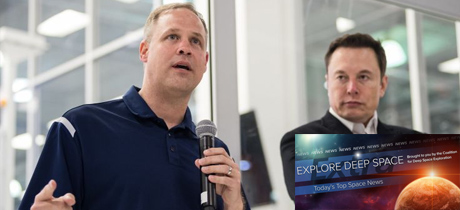In Today’s Deep Space Extra… The Moon is an attractive first destination in a future effort by humans from across the globe to explore deep space, a gathering of the world’s veteran astronauts in Houston contends. Though it originated from outside the solar system, comet 2I/Borisov displays a common chemistry.
Human Space Exploration
Veteran astronauts endorse NASA’s program for a return to the Moon
Ars Technica (10/14): The Association of Space Explorers (ASE) convened in Houston on Monday for its annual planetary science conference, an event that brings veteran space fliers together from every major continent on Earth. There was broad support for NASA’s efforts to return to the surface of the Moon with human explorers to prepare for future expeditions to Mars. Some though questioned the realism of attempting to accelerate a planned return from 2028 to 2024. There was strong agreement in the value of an international effort, modeled after the International Space Station in which the participants share the costs and the benefits.
NASA chief: SpaceX and Boeing have critical tests ahead but could fly astronauts in early 2020
Coalition Members in the News – Boeing, Lockheed Martin
CNBC.com (10/13): SpaceX and Boeing are each in the final stages of developing the spacecraft needed for the U.S. to once again fly astronauts, with NASA’s leader estimating launches may happen as early as the first months of 2020. “I think both systems could be ready in the first quarter of next year,” NASA Administrator Jim Bridenstine told CNBC on Thursday.
Modern monetary theory and lunar development (Op Ed)
The Space Review (10/14): The challenges associated with human space exploration need to be depoliticized, writes Vidvuds Beldavs a founding member of the International Lunar Decade Working Group formed in November 2014. “Given that long-term goals have been agreed to, then maintaining funding to achieve the goals could result in not only achieving the goals but doing so sooner. It would be less wasteful and, by implication, much less costly over the long haul,” he writes in a lengthy essay.
Doctor urges NASA to follow astronauts until end of life to determine cancer incidence rates
Houston Chronicle (10/14): During a presentation on health concerns for astronauts assigned to future deep space missions, Dr. Richard Jennings, director for the Aerospace Medicine Residency Program at the University of Texas Medical Branch (UTMB) at Galveston, urged NASA to track their health until death in order to best determine the cancer threat posed by exposure to space radiation. Jennings was part of a panel that discussed the topic at Monday’s opening session of the Association of Space Explorers (ASE) annual Planetary Congress under way this week in Houston.
Space Science
Interstellar comet Borisov looks pretty normal, new observations suggest
Space.com (10/14): The latest observations of comet 2I/Borisov confirm that the recently discovered celestial object originated from outside the solar system, but it’s not unlike those that originate within our solar system.
The tail of interstellar comet Borisov
Spaceweather.com (10/14): Wherever comet 2I/Borisov originated — and that is somewhere beyond the solar system — its origins must be a place a lot like the solar system, astronomers have determined. 2I/Borisov is only the second outsider discovered traveling through the solar system from outside. The tail is emitting a strong chemical signature of cyanide.
Other News
China begins preparations for crucial Long March 5 rocket launch
SpaceNews.com (10/14): China’s Long March 5 and 5B variant heavy lift rocket are critical to the launch of Beijing’s Mars mission next year, the future assembly of an independent space station and other human space exploration endeavors. A late December launch planned to place an experimental communications satellite in geosynchronous transfer orbit will demonstrate whether the rocket has overcome a failed July 2 launch traced to the Long March 5 core stage. The inaugural Long March 5 launch in November 2016 did not place its payload in the intended orbit, though second stage performance was able to make a correction.
Army looks for alternatives to GPS as enemies threaten to jam signals
SpaceNews.com (10/14): A top U.S. Army general said Monday the service is looking to become less dependent on GPS enable devices to provide pointing, navigation and timing because adversaries are fielding advanced electronic jammers. General John Murray, commander of Army Futures Command, summarized the issue at the Association of the U.S. Army annual conference.

